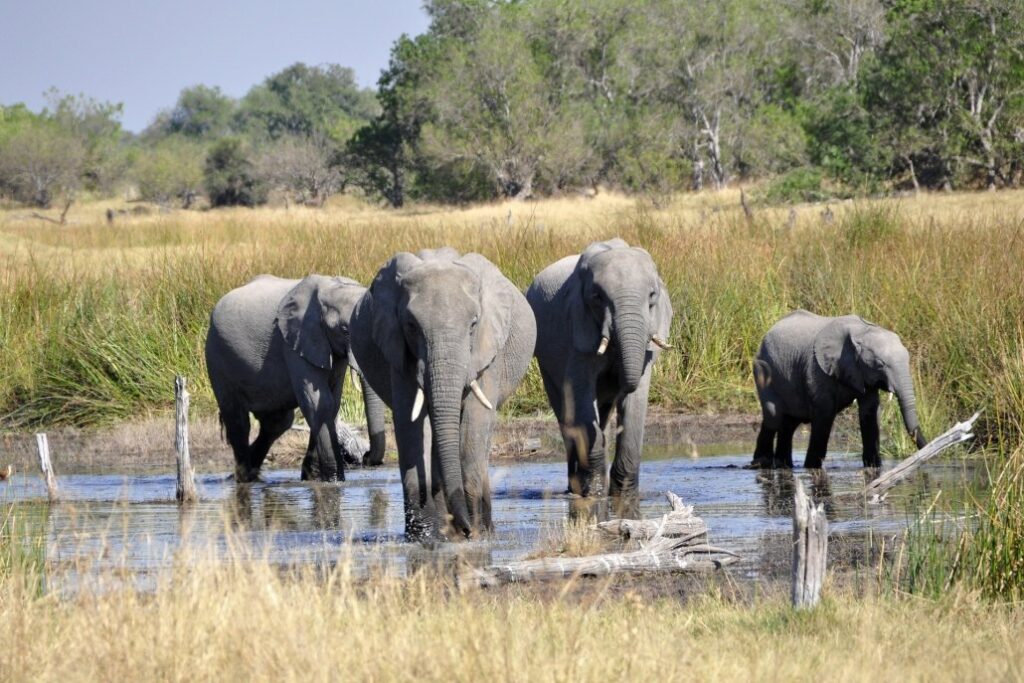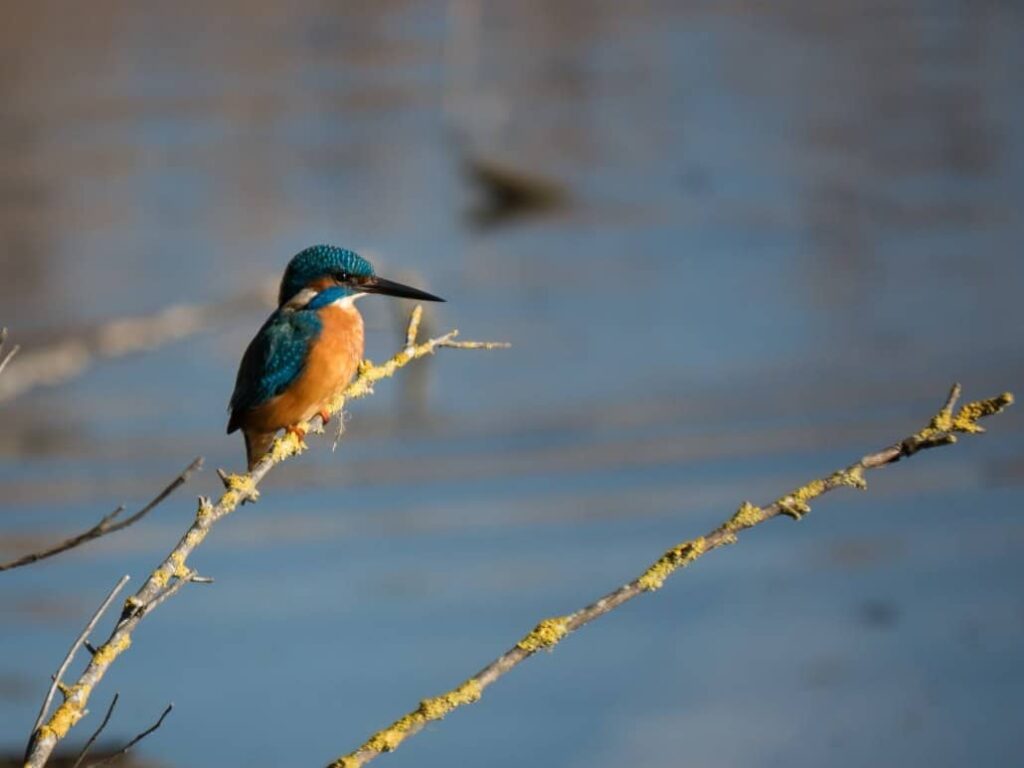The African continent is by no means short of exceptional places to go on safari and see some of the world’s most captivating species of wildlife – so for the Okavango Delta to be considered among the very top speaks to the fact it’s truly remarkable. As a UNESCO World Heritage listed site, you’ll find a myriad of creatures on land, in water and in the air; visible on watery islands, amongst grass and reeds or even hiding in the dark shadows of the trees.

The Okavango Delta is is one of the biggest inland deltas on the planet, sustaining life with thanks to the Okavango River in Botswana. It’s a location which changes greatly with the seasons, which is why the answer to the question of the best time to visit varies, as no two months are exactly the same. Allow us to break it down for you, month by month.
January is an amazing time in the Okavango Delta if you’re fascinated by birdlife. This is the peak time for breeding for many of the migrant birds who settle here at this time of year. Of course, that’s not everything the region has to offer, but the game viewing at this time is not at its best. Rainy season is in full swing by January, and there is a possibility your safari might even be rained off. However, there’s something truly breathtaking about the sight of an Okavango Delta thunderstorm, watching lightning crack the sky and its luminescent reflections in the water.
This time of year is a wonderful time for photography enthusiasts to take some incredible snaps;there are dramatic colours everywhere you look, from the flowers to the foliage and everything in between.
Like January, February falls in the region’s rainy season, but there are plenty of sunny days and blue skies to enjoy at times as well. The key to the rainy season is understanding its sheer unpredictability – there are no strict patterns from year to year and so you never know what you’re going to get. Regardless, even on stormy days the temperatures will reach extreme highs, so keep that in mind.
As you might imagine, the roads leading to the game reserves aren’t at their best in February, thanks to the constant onslaught of rain, and this means there’s a lot of mud all over the place. Unfortunately, this still isn’t the best time for game viewing, but as the animals obviously don’t fully disappear, you just have to look closer through the thick vegetation. On the other hand, there are plenty of birds to be seen, as well as little creatures such as butterflies and frogs.
March brings a welcome relief from the seemingly incessant rains of the previous two months, and while the temperatures remain fairly constant and warm, dry weather is far more practical.
This time of year is especially beautiful because the bush around you is still lush and green, andthe flowers are still in bloom.
If you’re an elephant enthusiast, you’ll have a particular affinity to the Okavango Delta in March. They flock to the local Marula trees where they enjoy their favourite fruits, which means that you’ll hopefully see plenty of them throughout your trip.

Temperatures begin to drop by April, especially during the night. However, you must not be fooled – they are still able to reach in excess of 40°C. For the most part though, you’ll enjoy very pleasant, warm days.
There are still remnants of mud from the rainy season, but for the most part, there’s still lots to see and do. Mokoro boat trips can be taken this month, and as you float along past the flower and fruit trees, you can take photographs galore. The floodwaters have well and truly risen by April and the sight is absolutely breathtaking.
In terms of wildlife, reptiles, baboons and impala are absolutely everywhere; the latter often making rather dramatic scenes as the males fight for partners with whom to breed.
Many people say that the very best month of the year to visit the Okavango Delta is May, and it is not at all difficult to see why. Temperatures are incredibly moderate and the skies remain blue all day long – by now, the dry season has arrived. The floodwaters have reached their peak and begin to progress through the area.
If you’re hoping to see predators, they are present, but they’re usually far more abundant later in the season when their prey is easier to find. That is not to say that you won’t find their hiding places, particularly when engaging the help of an extremely skilled tracker or guide. In the meantime, there are still lots of herbivores to be seen all around, buffalo herds at the water sources and birds that have not yet migrated for the winter.
It should come as no surprise that June is yet another brilliant month to see the Okavango Delta, however, you ought to note that this is not a particularly well-kept secret. The crowds begin increasing around this time of year, which means that safaris are fully booked well in advance. You will need to plan ahead, but once your place is secure, you will still find the experience fairly intimate because places in all of the lodges and camps are purposefully limited.
There is a real mix of water and land based activities this month, which makes it incredibly versatile. By now, the vegetation is beginning to thin and so you’re much more likely to spot predators. Keep your eyes out for African wild dogs as well – you can often see them around taking care of their puppies.
Despite the fact that July is the coldest time of year in the Okavango Delta, daytime highs still reach around 25°C. However, when night falls, you will really feel the drop in temperatures. Even though it’s still dry season, water finally reaches previously untouched areas which means that Mokoro boat trips and other water activities are accessible almost everywhere.
It is still peak season in July, which again makes sense. You will witness high floodwaters and even spot some greenery, still present from the summertime. Game viewing of predators is great because visibility is getting better, and you’ll also see the likes of elephant and buffalo along the northern fringe as well as to the east and south.

There is no bad part of the Okavango Delta to be found in August. Temperatures are already starting to warm up again, and so birds are all around once again. While it’s still peak season, you’ll barely notice – all visitors are in for a treat.
You’ll be spoiled for choice all over the Delta, from the game viewing spots in the north allowing for sightings of lions and leopards to the angling areas of the Panhandle. At the Moremi Game Reserve, there’s wildlife aplenty, and lots of opportunities for incredible boating trips thanks to the high floodwaters. Further south, you can even take a safari on horseback.
The onset of September brings a dramatic rise in temperatures which signal winter coming to anend. The cold nights become far warmer and during the day, there is sunshine all around. The birds are back and beginning nesting, and the floodwaters are beginning to drop.
If your major draw to the Delta is the big predators, then you’re going to want to visit this month. As the landscapes become drier and drier, they become easier and easier to spot. Both prey and predators can be found at the water sources, because this is the only water they’re each going to find.
It’s bad luck for fish this month; as the more shallow waterways begin to dry, they attract a plethora of different birds of prey to try their luck at catching the stranded fish. The fights they have among themselves are certainly worth seeing!
October is a scorching month, but it’s worth pushing through the heat to see the spectacular sights in terms of game viewing and fishing frenzies. Predators are incredibly likely to be seen, as are some of the more unusual kinds of birds around the deeper lagoons.
Water activities are hit or miss around this time of year, depending on how dry the conditions are. This means that most lodges are now further from the water as well, which does slightly change the atmosphere. However, if you are content with seeing animal after animal, you are hardly likely to notice.

There’s no easy way to define November – some years, the conditions remain dry and therefore viewing of predators remains steady. However, this is not typical. The rains usually begin again around the middle of the month, and with their arrival, there are yet more dramatic scenes in the form of storms. Colours once again begin to “pop”, with greenery once again bursting into life and replacing the dry and arid landscapes.
Generally, when the rains come, the predators are once again more difficult to see, and some safari experiences may even be cancelled. Lots of baby animals are born around this time of year, which unfortunately leads predators to seek them out – but such is the reality of the circle of life in full swing.
Dramatic skies and storms can be found throughout the month and it’s a great time for fans of striking photography. However, you might find yourself missing out on your safari because they are often rained out. In spite of the rain, water levels are usually low, and so you won’t be able to partake in water activities, either.
If you love baby animals, December is a wonderful month, with the signs of new life visible everywhere. The young grow quickly, with the need to be strong to escape the predators which are constantly looming in watch. Thankfully, they are less camouflaged at this time of year, but on the downside, they can hide in bush land which is once again growing, which can also make them more difficult to spot.

SIGN UP